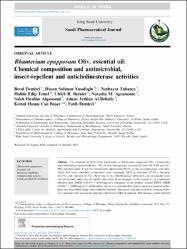| dc.contributor.author | Demirci, Betül | |
| dc.contributor.author | Yusufoğlu, Hasan Soliman | |
| dc.contributor.author | Tabanca, Nurhayat | |
| dc.contributor.author | Temel, Halide Edip | |
| dc.contributor.author | Bernier, Ulrich R. | |
| dc.contributor.author | Agramonte, Natasha M. | |
| dc.contributor.author | Demirci, Fatih | |
| dc.date.accessioned | 2019-10-19T14:03:40Z | |
| dc.date.available | 2019-10-19T14:03:40Z | |
| dc.date.issued | 2017 | |
| dc.identifier.issn | 1319-0164 | |
| dc.identifier.issn | 2213-7475 | |
| dc.identifier.uri | https://dx.doi.org/10.1016/j.jsps.2016.10.009 | |
| dc.identifier.uri | https://hdl.handle.net/11421/12649 | |
| dc.description | WOS: 000406021100005 | en_US |
| dc.description | PubMed ID: 28725142 | en_US |
| dc.description.abstract | The essential oil (EO) of the aerial parts of Rhanterium epapposum Oliv. (Asteraceae), was obtained by hydrodistillation. The oil was subsequently analyzed by both GC-FID and GC-MS, simultaneously. Forty-five components representing 99.2% of the oil composition were identified. The most abundant compounds were camphene (38.5%), myrcene (17.5%), limonene (10.1%) and alpha-pinene (8.7%). Referring to the ethnobotanical utilization, an insecticidal assay was performed, where the oil repelled the yellow fever mosquito Aedes aegypti L. at a minimum effective dose (MED of 0.035 +/- 0.010 mg/cm(2)) compared to the positive control DEET (MED of 0.015 +/- 0.004 mg/cm(2)). Additionally, the in vitro antimicrobial activity against a panel of pathogens was determined using a microdilution method. The acetyl- and butyrylcholine esterase inhibitory activities were measured using the colorimetric Ellman method. The bioassay results showed that the oil was rather moderate in antimicrobial and cholinesterase inhibitions when compared to the standard compounds | en_US |
| dc.description.sponsorship | Deployed War-Fighter Protection Research Program - U.S. Department of Defense through Armed Forces Pest Management Board | en_US |
| dc.description.sponsorship | We thank Greg Allen (USDA-ARS, Center for Medical, Agricultural, and Veterinary Entomology, Gainesville, FL) for performing the mosquito bioassays. This study was supported partially by the Deployed War-Fighter Protection Research Program Grant funded by the U.S. Department of Defense through the Armed Forces Pest Management Board. | en_US |
| dc.language.iso | eng | en_US |
| dc.publisher | Elsevier Science BV | en_US |
| dc.relation.isversionof | 10.1016/j.jsps.2016.10.009 | en_US |
| dc.rights | info:eu-repo/semantics/openAccess | en_US |
| dc.subject | Rhanterium Epapposum | en_US |
| dc.subject | Essential Oil | en_US |
| dc.subject | Botanical Repellents | en_US |
| dc.subject | Antimicrobial Activity | en_US |
| dc.subject | Ache And Buche Inhibition | en_US |
| dc.title | Rhanterium epapposum Oliv. essential oil: Chemical composition and antimicrobial, insect-repellent and anticholinesterase activities | en_US |
| dc.type | article | en_US |
| dc.relation.journal | Saudi Pharmaceutical Journal | en_US |
| dc.contributor.department | Anadolu Üniversitesi, Eczacılık Fakültesi, Farmakognozi Anabilim Dalı | en_US |
| dc.identifier.volume | 25 | en_US |
| dc.identifier.issue | 5 | en_US |
| dc.identifier.startpage | 703 | en_US |
| dc.identifier.endpage | 708 | en_US |
| dc.relation.publicationcategory | Makale - Uluslararası Hakemli Dergi - Kurum Öğretim Elemanı | en_US |
| dc.contributor.institutionauthor | Demirci, Betül | |
| dc.contributor.institutionauthor | Temel, Halide Edip | |
| dc.contributor.institutionauthor | Demirci, Fatih | |


















